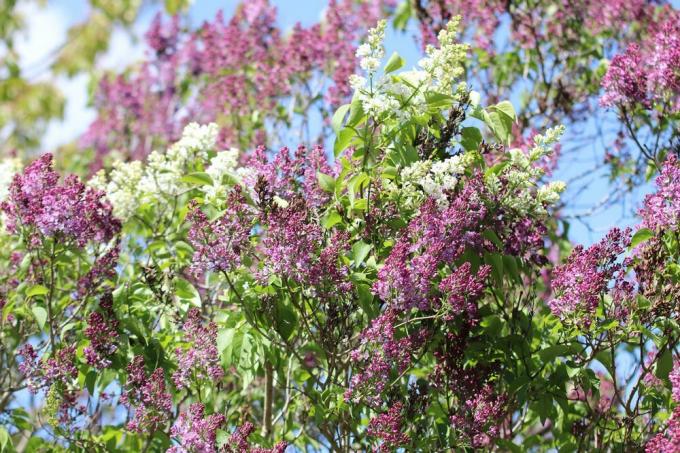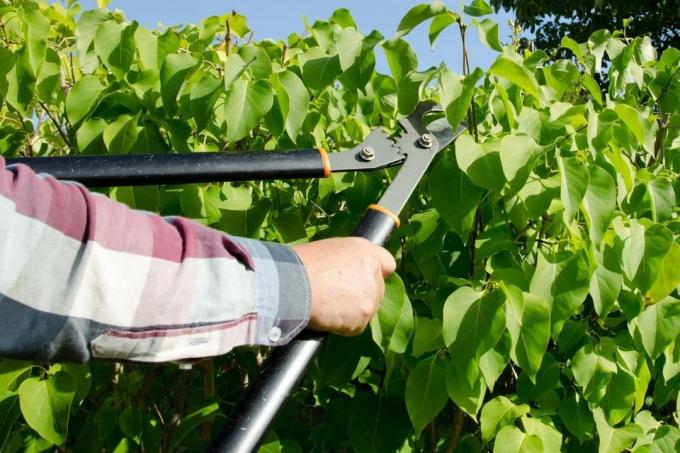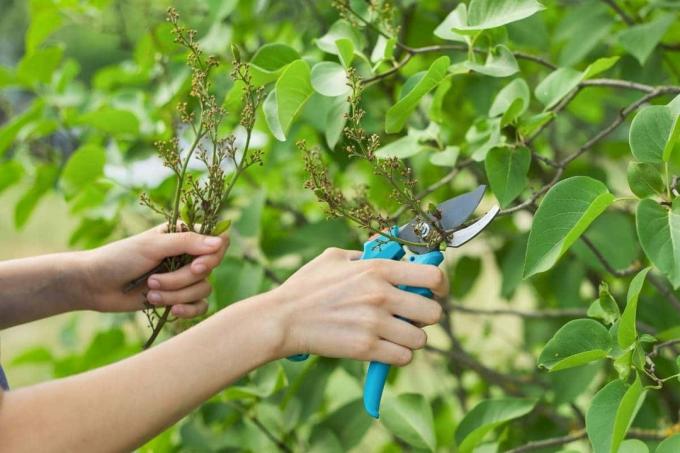
Table of Contents
- Rejuvenate aged lilacs
- Perform the taper cut correctly
- Tools used
- Prevent aging
- frequently asked Questions
Over the years the lilac sometimes bald from below. A taper cut on the lilac can help. With the right technique, the lilac bush will soon shine again in its old beauty.
In a nutshell
- can live to be 50 to 60 years old
- rejuvenate over several years
- only cut back the main branches
- Cut knee-high to above the ground
- after pruning compost
Rejuvenate aged lilacs
Lilacs (Syringa) can reach an impressive age of 50 to 60 years under good conditions. Every year he then drives out again and pampers you with a luscious blossom. Normally, the ornamental wood hardly needs any pruning. However, the garden classic can become bare from below over the years. The branches then have only a few leaves and the flowers are just as sparse. The base is usually completely bare. It is then time to rejuvenate the lilac bush or tree from scratch. The rejuvenating pruning should not be done all at once, but the pruning of the lilac should be spread over a period of two to three years. This can prevent the bloom from failing completely over several years.

Notice: A complete one Radical cut should not be done if possible. The overaged wood could not stand the rigorous cutting and die.
Perform the taper cut correctly
The pruning to rejuvenate should be done in early spring, even before flowering. The days should be frost-free. The procedure is then as follows
- Cut main branches to different heights
- Cut back a third to half of the main branches annually
- Lilac bushes knee high to just above the ground
- but at least 20 to 30 cm above the surface of the earth
- at Trees shorten depending on the height
- sprout again quickly
- from the new shoot in the following spring only two to three strong branches remain
- shorten these again as described
- this ensures good branching and vigorous growth
- Completely remove all dried up, crossing, inward-growing shoots
- Completely dig up the root runners

Tools used
Can be used depending on the strength of the branches
- Anvil loppers and
- Pruning saw
The tools need to be clean and sharp being. Before and after each use, they should be disinfected with alcohol. The interfaces must be smooth and not squashed so that none Pathogens can enter the cuts. Larger wounds are closed with a wound closure agent such as tree wax.
Notice: So that the lilacs can sprout well after the rejuvenation cut, compost and horn shavings should be added. These are carefully worked into the soil in the root area.
Prevent aging

After the overaged lilac has been rejuvenated, a small pruning and clearing of the wood should be carried out annually after flowering, at the end of May:
- Remove overaged branches
- Cut off all withered flower clusters
- Attach scissors above the outward-facing eye directly under the flowers
- dead, withered and cut off the diseased branches at the base
- this also includes: intersecting and inwardly growing or widely spaced shoots
- Remove root shoots completely at the base
Tip: Accrued clippings can be used Propagation of cuttings and can also be used for finishing.
frequently asked Questions
Lilac loves a sunny spot. It also grows in the shade, but it hardly sets flowers there and the crown does not become dense. The bushes tolerate dry heat well. Noble lilac prefers a high lime content, as well as dry and nutrient-rich clay soils. However, it also grows on unfavorable soils, but not as abundantly. However, the lilac is very sensitive to waterlogging and compaction of the soil.
Usually lilac is easy to care for. Even in dry weather no large amounts of water are necessary. Fertilization should be carried out once a year in spring. To do this, a thin layer of compost is applied to the tree grate. In a sandy location, however, additional nutrients in the form of slow release fertilizers or horn shavings are necessary. After flowering at the end of May, it is necessary to cut the faded ribs. This stimulates flower formation for the coming year.
No, even if the Syringa is not a native wood, it is hardy in this country. Only young lilac bushes should receive protection in the first two to three years after planting. a mulch layer of leaves or straw in the root area would be advisable. This can be covered with spruce branches. Plants in the tub are placed on a wooden or styrofoam plate and the tub is covered with fleece.


